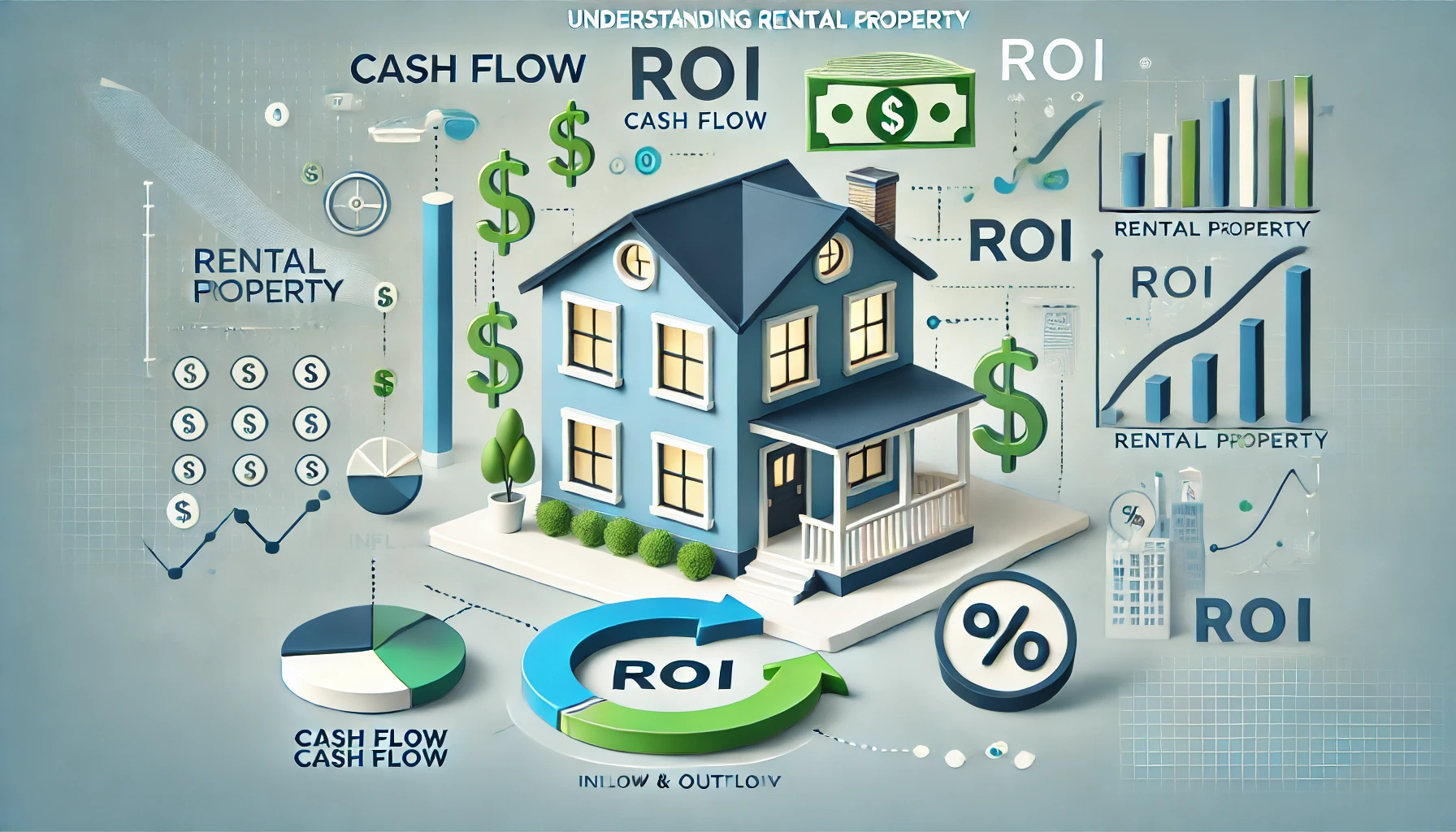Understanding Rental Property
Investing in rental properties can be a lucrative venture, but understanding the financial metrics involved is crucial for success. Cash flow and return on investment (ROI) are two essential metrics that every real estate investor should grasp. In this article, we’ll break down these concepts, provide examples, and offer tips to help you make informed investment decisions.
What is Cash Flow?
Cash flow is the net amount of money moving in and out of your rental property investment. It’s the difference between your rental income and your expenses. Positive cash flow means your property is generating more income than it costs to maintain, while negative cash flow indicates that your expenses exceed your rental income.
Calculating Cash Flow: To calculate your cash flow, follow these steps:
- Determine your gross rental income: This is the total amount of rent you collect from your tenants.
- Subtract your operating expenses: This includes property management fees, maintenance costs, property taxes, insurance, and any other regular expenses.
- Subtract your mortgage payments: If you have a loan on the property, deduct your monthly mortgage payments.
- Account for vacancy rates and repairs: Set aside a portion of your income for potential vacancies and unexpected repairs.
Example: Let’s say you own a rental property that generates $2,000 in monthly rent. Your monthly operating expenses are $500, and your mortgage payment is $1,200. Additionally, you set aside $100 for vacancies and $100 for repairs. Your monthly cash flow calculation would look like this:
Gross Rental Income−(Operating Expenses+Mortgage Payments+Vacancies+Repairs)\text{Gross Rental Income} – (\text{Operating Expenses} + \text{Mortgage Payments} + \text{Vacancies} + \text{Repairs})Gross Rental Income−(Operating Expenses+Mortgage Payments+Vacancies+Repairs) $2,000 – ($500 + $1,200 + $100 + $100) = $100
In this scenario, you have a positive cash flow of $100 per month.
Understanding ROI
ROI measures the profitability of your rental property investment. It tells you how much return you are getting on your investment relative to its cost. There are different ways to calculate ROI, but the most common methods include the cap rate and cash-on-cash return.
Calculating Cap Rate: The cap rate is the ratio of your net operating income (NOI) to the property’s current market value. It’s a useful metric for comparing different investment properties.
Cap Rate=Net Operating Income (NOI)Current Market Value×100\text{Cap Rate} = \frac{\text{Net Operating Income (NOI)}}{\text{Current Market Value}} \times 100Cap Rate=Current Market ValueNet Operating Income (NOI)×100
Example: If your property has an annual NOI of $12,000 and a market value of $200,000, your cap rate would be:
\frac{$12,000}{$200,000} \times 100 = 6\%
A higher cap rate generally indicates a more profitable investment, but it’s essential to consider other factors such as property location and market conditions.
Calculating Cash-on-Cash Return: Cash-on-cash return measures the annual return on the actual cash invested in the property. It’s calculated by dividing the annual pre-tax cash flow by the total cash invested.
Cash-on-Cash Return=Annual Pre-Tax Cash FlowTotal Cash Invested×100\text{Cash-on-Cash Return} = \frac{\text{Annual Pre-Tax Cash Flow}}{\text{Total Cash Invested}} \times 100Cash-on-Cash Return=Total Cash InvestedAnnual Pre-Tax Cash Flow×100
Example: If you invested $40,000 in a rental property and your annual pre-tax cash flow is $4,800, your cash-on-cash return would be:
\frac{$4,800}{$40,000} \times 100 = 12\%
Tips for Maximizing Cash Flow and ROI
- Choose the right property location: Properties in desirable areas with high demand for rentals typically offer better cash flow and ROI.
- Negotiate favorable purchase prices: Buying properties below market value increases your potential for higher returns.
- Minimize operating expenses: Efficiently managing your property and reducing unnecessary costs can significantly improve your cash flow.
- Consider property improvements: Strategic renovations can increase rental income and property value, enhancing your ROI.
- Use leverage wisely: While taking a mortgage can increase your ROI, ensure that your rental income comfortably covers your loan payments and other expenses.
When it comes to understanding rental property cash flow and ROI, savvy investors know that location is key. Properties in high-demand areas tend to generate higher rental incomes, which directly impacts your cash flow. Additionally, smart property management and strategic renovations can boost your property’s attractiveness, leading to better occupancy rates and rental yields. By diligently calculating your cash flow and ROI, you can make informed investment decisions that align with your financial goals.
Examples and Case Studies
Let’s consider a real-world example to illustrate these concepts. Suppose you purchase a rental property for $300,000 in a growing suburban area. You put down 20% ($60,000) and finance the rest with a mortgage at a 4% interest rate. The property generates $2,500 in monthly rent.
Yearly Calculations:
- Gross Rental Income: $2,500 x 12 = $30,000
- Operating Expenses: $600 per month x 12 = $7,200
- Mortgage Payments: $1,145 per month x 12 = $13,740
- Vacancy and Repairs Reserve: $200 per month x 12 = $2,400
Annual Cash Flow: Gross Rental Income−(Operating Expenses+Mortgage Payments+Vacancy and Repairs Reserve)\text{Gross Rental Income} – (\text{Operating Expenses} + \text{Mortgage Payments} + \text{Vacancy and Repairs Reserve})Gross Rental Income−(Operating Expenses+Mortgage Payments+Vacancy and Repairs Reserve) $30,000 – ($7,200 + $13,740 + $2,400) = $6,660
Cap Rate: Net Operating Income (NOI) – Operating ExpensesProperty Value×100\frac{\text{Net Operating Income (NOI) – Operating Expenses}}{\text{Property Value}} \times 100Property ValueNet Operating Income (NOI) – Operating Expenses×100 \frac{$30,000 – $7,200}{$300,000} \times 100 = 7.6\%
Cash-on-Cash Return: Annual Pre-Tax Cash FlowTotal Cash Invested×100\frac{\text{Annual Pre-Tax Cash Flow}}{\text{Total Cash Invested}} \times 100Total Cash InvestedAnnual Pre-Tax Cash Flow×100 \frac{$6,660}{$60,000} \times 100 = 11.1\%
Conclusion
Understanding cash flow and ROI is fundamental to making wise rental property investments. By carefully analyzing these metrics, you can identify properties that will provide you with the best returns and long-term financial stability. Remember, the key to successful real estate investing lies in thorough research, strategic planning, and effective property management. Whether you’re a seasoned investor or just starting, mastering these concepts will set you on the path to success in the rental property market.

